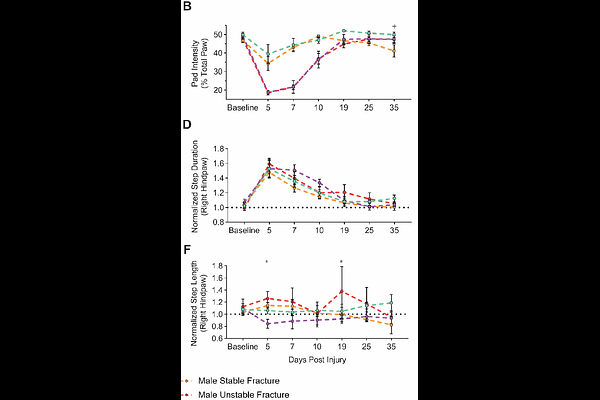Deep behavioral phenotyping tracks functional recovery following tibia fracture in mice

Deep behavioral phenotyping tracks functional recovery following tibia fracture in mice
Layne, J. E.; Snapper, D. M.; Czachor, M. E.; Lam, C.; Matityahu, J. D.; Lind, D. R. G.; Huard, M.; Morioka, K.; Motzkin, J. C.; Basbaum, A. I.; Weinrich, J. A. P.; Bahney, C. S.
AbstractIntroduction: An estimated 178 million fractures occur worldwide each year, with lower limb fractures in particular showing a high incidence of poor healing, and these often lead to reduced mobility and chronic pain. Bone healing and the ability to bear weight are closely tied to the mechanical stability of the fracture site. Although fracture stabilization is a well-established factor modulating the rate and extent of bone repair, there is a notable gap in non-destructive technologies that can rapidly and objectively quantify functional recovery in preclinical settings. We consider this to be a significant limiting factor in translational studies directed at improving fracture healing. Here, we describe a novel behavioral phenotyping approach that enables rapid quantification of post-fracture weightbearing and kinematic metrics in freely behaving mice. Our goal is to identify and characterize metrics most indicative of fracture-induced behavioral impairment and to use these metrics to quantify how functional recovery is altered in mice with pin stabilized versus non-stabilized fractures. We also use this approach to explore whether sex is a significant contributor to functional recovery. Methods: Male and female adult C57BL6/J received a mid-shaft tibial fracture that was either left unstabilized or fixed with an intramedullary pin. Non-fractured naive mice served as controls. Behavioral recordings of freely moving mice were acquired prior to fracture and then throughout the time course of healing, from 5 to 35 days post fracture (DPF). To track mice and analyze changes in paw pressure and kinematic behaviors after fracture, we then applied a novel machine learning-enabled behavioral phenotyping analysis. Results: In this study, we demonstrate that severity of the behavioral phenotype is more significant in mice with unstabilized fractures when compared to mice with pin-stabilized fractures. Pin stabilization generally allowed increased weightbearing and produced smaller changes in kinematic metrics. Interestingly, we observed only minor sex specific differences in fracture-induced behavioral impairments and recovery. Our analysis also revealed that functional recovery is more complex than is a set of individual parameters viewed in isolation. In fact, unique behavioral parameters identified different time windows for functional recovery. Therefore, we developed a comprehensive, unified graph theoretic metric of fracture recovery that encompasses all behavioral parameters quantified. Using this unified metric, we confirmed the increased severity of the fracture phenotype in unstabilized versus pin stabilized mice and identified a clear time window of functional recovery, for both fracture groups. Discussion: Our findings demonstrate how this novel comprehensive behavioral phenotyping approach, which combines machine learning and graph theory, makes it possible to rapidly quantify longitudinal changes in mice after fracture. This approach enables us to determine functional recovery patterns based on a unified behavioral metric of healing. Our data and methodology form a foundation for future mechanistic experiments focused on understanding biological or mechanical variables that influence functional healing and will also enable more rapid testing of various strategies to accelerate bone healing.